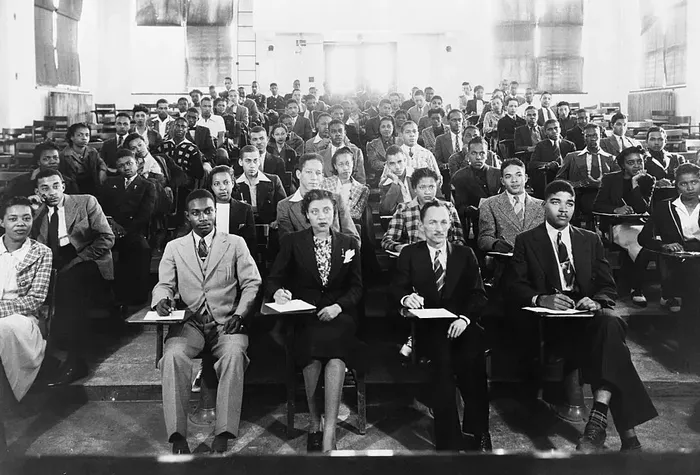On May 5, the Metropolitan Museum of Art hosted its renowned Met Gala, the annual fundraising event that draws prominent figures from art, business, politics, sports, and entertainment to support the museum’s Costume Institute.
Each year, attendees follow a dress code that reflects the theme of the Costume Institute’s spring exhibition. For 2025, the theme, “Tailored for You,” encouraged guests to showcase tailored fashion, spotlighting craftsmanship and design excellence.
This year’s theme is rooted in the Institute’s exhibition, Superfine: Tailoring Black Style, which pays tribute to 250 years of iconic Black men’s fashion. The exhibit explores how Black men across the Atlantic world have used clothing as a tool for self-expression and resistance during pivotal moments in history marked by societal and political transformation.
Both the exhibit and the gala’s fashion theme invoke historical dialogue about the visibility and representation of Black masculinity. Central to this discussion is W.E.B. Du Bois’s concept of “double consciousness”—the internal conflict faced by African Americans who navigate their personal identities alongside the racial identity imposed by society. Through fashion, Black men have often reconciled this duality by expressing their style preferences while contending with the expectations of the Western gaze.
During the American Revolutionary War, clothing symbolized deeper ideological struggles. Black men, both enslaved and free, lobbied to fight for American independence, eager to demonstrate their masculinity and patriotism. While George Washington, as commander of the Continental Army, eventually permitted free Black men to enlist, he barred enslaved individuals from serving, offering no promise of emancipation for military service.
In response, many enslaved men defected to the British side, forming what was known as the “Ethiopian Regiment.” Comprising self-emancipated African Americans, this unit wore distinct purple uniforms with sashes emblazoned with “Liberty to Slaves,” a symbolic contrast to both the American blue and British red uniforms. Their dress was a powerful visual assertion of individual and collective liberation.
By the late 19th and early 20th centuries, fashion continued to serve as a political and cultural statement. Black men attending newly established historically Black colleges and universities often adopted formal business attire, a strategic decision to challenge racist assumptions and claim dignity during the oppressive post-Reconstruction era. These students, many of whom were children of formerly enslaved individuals, faced threats from white supremacist groups like the Ku Klux Klan and the rising tide of voter suppression and lynchings in the South.
In defiance, these young men presented themselves in crisp jackets, waistcoats, trousers, and ties, echoing white-collar respectability and countering prevailing stereotypes that sought to undermine Black achievement and intelligence.
This legacy of collegiate fashion inspired designer Ralph Lauren’s 2022 collection, which honored Morehouse College traditions. His designs featured wool flannel blazers and classic tailored garments, referencing the tradition of gifting blazers to incoming students at the all-male institution.
Suits maintained their prominence in Black fashion throughout the 20th century. During the Civil Rights Movement in the 1950s and 1960s, activists frequently wore formal attire—dark suits, ties, and white shirts—to underscore the seriousness of their cause and align their image with ideals of justice and dignity. Their deliberate sartorial choices emphasized a commitment to the democratic principles championed in the nation’s founding documents and reaffirmed during the Civil War and Reconstruction.
By the late 20th century, Black fashion began shifting toward styles that celebrated individuality. Athleisure and streetwear—fusions of casual sportswear and expressive personal style—gained prominence. These new forms of dress drew influence from sports culture, hip-hop, African aesthetics, and grassroots social groups. This era saw widespread cultural adoption of off-duty styles, such as Nike’s “Jordans,” introduced in 1985 and named after basketball icon Michael Jordan, which remain a staple of urban fashion.
In the 21st century, Black creatives began merging streetwear with haute couture. Designer Virgil Abloh, a key figure in this movement, successfully integrated sportswear elements with luxury fashion. His appointment in 2018 as the first Black menswear artistic director at Louis Vuitton marked a historic moment in the evolution of fashion and cultural representation.
Today, Black men continue to use fashion to engage with and resist societal expectations, as well as to affirm their identities and aspirations. Whether in political arenas, professional spaces, or cultural events like the Met Gala, clothing remains a medium of both personal expression and collective empowerment.
This year’s Met Gala, with its focus on tailored style and its tribute to centuries of Black fashion, is expected to reflect this ongoing legacy. Guests are anticipated to embrace fashion as not only an art form but also a vehicle for visibility, pride, and resistance.
Related Topics
- Pilot’s Wife Warns Women About Risky Airport Fashion Choices
- Crowborough Fashion Brand AYM Studio Wins Prestigious King’s Award for Enterprise
- Kentucky Derby Supports Influencer After Backlash Over Bold Outfit Choice

